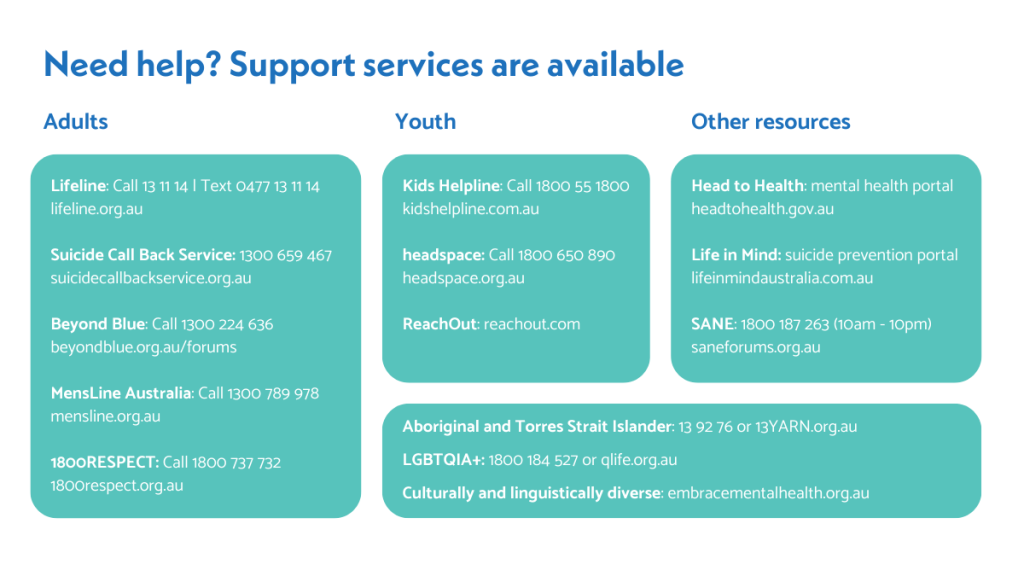The internet has become an integral part of our lives, offering countless opportunities for learning, communication, and entertainment. But there can be downsides too, particularly for parents of teenagers, from cyberbullying to excessive screen time. And it can be hard to find a balance between freedom and rules – especially when access to devices is so easy these days. Let’s explore some common concerns and practical tips for parents to help their teens safely navigate the internet.
What concerns do parents have?
ReachOut have recently released the results of their latest study, Parenting in the digital age: Navigating concerns about the online world of young people. They surveyed 631 parents and carers across Australia, asking them about the issues that concerned them most when it comes to screen time and its impacts on mental health. Here are some of the key takeaways:
- 59% of respondents were concerned about young people’s use of social media.
- 55% reported ‘quite a bit’ or ‘a lot’ of impact on wellbeing.
- 66% said internet use was a top issue for children under 15.
- 11% reported that they didn’t feel at all equipped to manage issues with internet and social media use.
- Nearly 60% needed support in the last 12 months to find quality, trusted information.
- Four key themes were identified: time, safety, content, and parental controls.
- Some argued that the platforms themselves needed to take some responsibility for youth wellbeing and safety.
“I want help from social media companies or tech companies themselves to limit their use.”
F, major city – Parenting in the digital age: Navigating concerns about the online world of young people
Back in 2019, eSafety also conducted research into the experience of parent’s raising children in the digital world in their report Parenting in the digital age. They surveyed 3,520 parents of children aged 2–17 in Australia and found:
- 94% of parents regard their child’s online safety as being important.
- 33% didn’t know where to get help if their child needed it.
- 95% agreed that they need additional online safety information…
- But only 36% actively sought out online safety information in the last 12 months.
- 37% of parents of 13 to 17-year olds were aware of their child having a negative online experience in the last 12 months.
- 37% believe technology companies aren’t doing enough to build safety features into their products and services.
- The most common concerns were privacy, protecting children from strangers, and spotting the signs and symptoms of a child experiencing negative incidents.
We can see that things haven’t really changed much in the last 5 years. Parents are still struggling to find helpful and trustworthy information about online safety, as well as feeling a lack of control over their child’s privacy and safety online.
Is screen time an issue for teens?
Getting your teen to stop scrolling might feel like rolling a boulder up a hill, but believe it or not, there can actually be positives around social media and other device use, including:
- Helping them bond with friends and family and preventing loneliness
- Learning about the world outside their home town or country
- Allowing them to be creative and share their ideas and thoughts
- Building some surprising important skills through gaming
- Just having fun!
Like all things, your teen will reap the most rewards by spending time online in moderation. Excessive screen time can lead to:
- Teens becoming disconnected from the real world
- Ignoring other important things, like school or work
- Stumbling across inappropriate content
- Decreased self-esteem
What can parents do to protect their teens online?
A lot of teens probably don’t want their parents knowing what they do online, and some of the topics around internet safety can be tricky to talk about. But open communication is a huge part of ensuring your child is safe. Here are some tips for helping you protect your teen’s safety and privacy online.
Be honest and open
You and your teen probably both cringe when broaching topics like sexting or pornography, but the reality is the more you talk about it, the easier it becomes. The AIFS found that the best way to educate children on these topics is to encourage open communication and discussion. Here are some tips from eSafety on approaching tricky subjects with your teen:
- Plan – before you say a word, first make sure you know what you want to say, how to say it, and where to have the conversation.
- Listen, don’t judge – snapping or being upset makes your teen less likely to approach you for help if they find themselves in trouble in the future.
- Ask questions – gauge what your teen already knows so you can focus on filling in the blanks.
- Get help – if you’re really struggling with what to say, you can get more advice from services like eSafety, Parentline, or ReachOut. If your teen really doesn’t want to talk to you, suggest that they can find help through Kids Helpline or headspace instead.
Build digital literacy
You might wish it wasn’t so, but the internet is here to stay, and it will probably be a big part of your teen’s life. Instead of trying to fight it, help them to build important digital literacy skills so they can surf online responsibly. Remind them to think critically about what they see and read online, as well as how the things they post might be viewed by others. Ask if they know about their digital footprint and make them aware that anything they post online stays there forever.
“Arming children and young people with tools to engage critically with media is important to their understanding of the differences between online pornography and their offline sexual relationships.”
Australian Institute of Family Studies – The effects of pornography on children and young people
Know what apps your teens are using
We’ve all heard of the big ones (like TikTok, Instagram, or Snapchat), but there are thousands of apps, games, and sites out there, all free to access with little to no restrictions. Arming yourself with knowledge can help you understand whether or not your teen is interacting with potentially inappropriate or dangerous content.
Start by simply asking your teen what their favourite apps or sites are. If you want to go in pre-armed, you might like to check out this comprehensive list from eSafety – it tells you what the app or site is, what it does or what it’s for, and provides helpful links to privacy policies and terms of use. Common Sense Media is another site you can use to find out more about the content your teen might be seeing or engaging with online.
Encourage privacy online
Make sure your teens (and you) know where and how to change the privacy settings on their social media accounts and other apps. Most of them have settings that allow you to restrict who can see and interact with your profile, prevent automatic sharing of other information from your device (like your location), or filter the content you can see.
Have a chat about the kinds of information it’s OK and not OK to share online. When playing games where you need a nickname or avatar, remind them to avoid using their real name or other identifying characteristics (like their birthday). And of course there is some information that should never be shared with strangers, like their address, full date of birth, or full name.
If they insist on playing games or using other apps with voice chat (e.g. Discord), let them know they can only do it if you’re able to listen in – for example, they need to play out in the lounge room, or use the TV speaker instead of headphones.
Set clear rules about screen time
Like we mentioned earlier, the use of devices in and of itself isn’t necessarily an issue; the amount of time and way it’s spent is more of a concern. Start by doing a “screen audit” in the household, tracking how much time is spent on devices each day or week. Then, sit down as a family and discuss what needs to happen next. Make sure to let your teen know that they are a key decision-maker in this process too and that their opinion is valued and heard.
When setting limits on screen time, it’s important to emphasise that they apply to the whole family – yes, even mum and dad. Taking the lead and setting a good example is important, particularly for parents of younger children, and can help your teen feel like the rules are less “unfair”.
Don’t forget to plan or suggest other activities you can do together with your new free time. Physical activity is a great way to take your mind off something, even if it’s just taking the dog for a quick walk around the block. You might like to bring out a board game or puzzle, or even just have a good old-fashioned face-to-face chat.
If your teen is really struggling to tear themself away from the screen, you might need to take it one step further. Many devices and apps now have built-in blockers, filters, and usage limits. There are external apps you can use to help with this too, like StayFocusd, Family Link, or Qustodio. You may also like to take a look at this list of accredited Family Friendly Filters from the Communications Alliance.
Online safety resources for parents
There are heaps of reliable and trustworthy sources of information about digital safety and privacy for parents and young people. Here are our top picks:
- eSafety
- ReachOut
- Raising Children Network
- Australian Institute of Family Studies
- Parentline’s Parenting in… Cyberspace podcast
- ThinkUKnow (note: the content on this site is about preventing online child sexual exploitation and may be distressing for some)
- Global Kids Online
- Children and Media Australia
- Kiwi Families
- Common Sense Media
- Ask About Games
- Youth Law Australia
You can also find other resources for parents on our website here.



